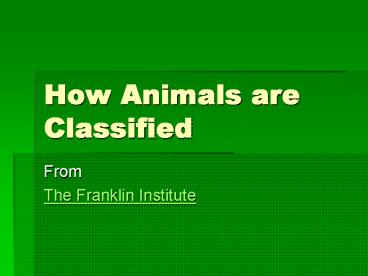How Animals are Classified PowerPoint PPT Presentation
1 / 17
Title: How Animals are Classified
1
How Animals are Classified
- From
- The Franklin Institute
2
To Begin. . .
- To begin to classify animals, consider the
backbone. Animals that have a backbone are called
vertebrates. Animals that do not have a backbone
are called invertebrates.
3
Backbones or No Backbones
- All invertebrates lack backbones, but their other
physical characteristics are quite varied. They
must be, considering that 95 percent of all
animals are invertebrates. Some, like worms, have
soft bodies with no bones at all. - Earthworms
- Worms
4
Invertebrates
- Some other invertebrates, like snails, have soft
bodies, but carry a hard shell for protection.
These soft-bodied invertebrates that live in
water or on land are grouped as mollusks. Besides
snails, some other mollusks are clams, mussels,
and squid. - First Graders Go Clamming
- Zebra Mussel Information Resources
- The Zebra Mussel Page
- Invertebrates of The Sea
5
Exoskeletons
- Some other invertebrates have tough coatings on
the outside of their bodies (exoskeletons),
jointed legs, and a segmented body. This group is
known as the arthropods. Insects, spiders
(arachnids), centipedes/millipedes, and shrimp,
lobster, and crabs (crustaceans) are all
arthropods. There are more insects (over 900,000
species) than any other group of arthropods.
There are more arthropods than any other group of
invertebrates. And, considering that 95 percent
of all animals are invertebrates, that makes
arthropods truly the must abundant group.
6
Weblinks
- Wonderful World of Insects
- 3-D Insects
- Spotlight on Insects
- Hotlist - Insects
- Entomologist
- Insects
- Minibeast World
7
- One particularly popular member of the insect
world is the butterfly. This arthropod, with its
tough outer shell, characteristic wings, and
antennae, belongs to the insect family. - Monarchs and Migration
- Monarch Watch
- Monarch/Viceroy Mimicry
- Entomology for Beginners - Metamorphosis
- Butterfly Pavillion and Insect center
- Chuck's Butterflies
- The Butterfly Website
- Painted Lady and Red Admiral Butterflies
- Thinking Fountain
- Journey North
- The Butterfly Farmer
- Caterpillars Butterflies
- The South Carolina Butterfly Project
8
Vertebrates
- All vertebrates have a backbone. Their other
physical characteristics are quite varied. One
way to consider groups of vertebrates is
according to their diet. Animals that primarily
eat plants are known as herbivores. Animals that
feed mostly on meat are known as carnivores. Some
animals, called omnivores, eat both plants and
meat.
9
Meat-eaters
- An animal's eating habits are influenced by its
anatomy. Meat-eaters have jaws and teeth designed
for tearing and crushing. The canine teeth are
enlarged and the molars have sharp cusps. The
intestinal tract is adapted for handling quick
digestion of meat. Plant-eaters usually have
large incisors for cropping and cutting plants.
Their large, ridged molars are adapted for
grinding tough plant fibers and their intestines
are rather long, allowing for slow digestion of
plant fibers.
10
Weblinks
- Hotlist - Animals
- Vertebrate Flight
- The Electronic Zoo
- Zoo TV
- African Wildlife Resource
- The Lincoln Park Zoo - Virtual Zoo and Live
Images - Carnivorous Plants
11
Cold- or Warm-blooded
- Another way to consider groups of vertebrates is
according to their body temperature. All
vertebrates are either cold-blooded or
warm-blooded. A vertebrate is considered
cold-blooded if its internal body temperature
matches the external temperature around it. Fish,
amphibians and reptiles are examples of
cold-blooded animals. Their dependence on the
water or land makes it necessary for them to
adapt to the temperature surrounding them.
12
Weblinks
- Reptiles Real and Robotic
- Salmon Page
- Salmon Club
- Fish Information Service
- Lincoln Park Zoo - Reptiles and Amphibians
- Jurassic Frogs
- Professor is Shell-Deep in Turtles
13
Warm-blooded
- Warm-blooded animals are able to control their
body temperature. No matter what the temperature
is outside, their internal body temperature
remains the same. Only birds and mammals are
warm-blooded. Birds rely upon their feathers to
help adapt to temperature changes.
14
Weblinks
- Ornithological Resources
- Geographical Birding Guide (N.A.)
- Lincoln Park Zoo Birdlist
- A Pigeon Inquiry
- Banana-Pusher
- American Birding
15
Mammals
- Mammals rely upon skin, hair, or fur to help
adapt to temperature changes. Another
characteristic of all mammals is the ability of
the female to produce milk to feed her babies.
Some mammals, like whales, live in the water and
must adapt to changing water temperatures. Other
land mammals, like wolves, have adapted to very
cold climates. In general, however, warm-blooded
animals must prepare for temperature extremes in
order to survive.
16
Weblinks
- Mammal Photos
- Lincoln Park Zoo - Mammals
- Wild Wolves
- What's So Bad About Bats?
17
Bibliography
- http//sln.fi.edu/tfi/units/life/classify/classify
.html

